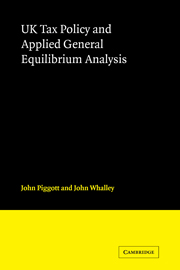Book contents
- Frontmatter
- Contents
- PREFACE
- ACKNOWLEDGEMENTS
- INTRODUCTION AND SUMMARY OF STUDY
- PART I The General Equilibrium Model of the UK – Structure, Data and Model Solution.
- PART II Empirical Analysis of the UK Tax/Subsidy System Using the General Equilibrium Model
- CHAPTER 7 Detailed Analysis of Central Case Model Experiment Involving Removal of Non-Savings/Non-Leisure Tax/Subsidy Distortion
- CHAPTER 8 Analysis of Structural Characteristics of the Tax/Subsidy System
- CHAPTER 9 Further Analysis of Tax/Subsidy Distortions
- SUMMARY AND CONCLUSIONS
- APPENDIX A Structure of the Basic Variant Model
- APPENDIX B Notes to Tables Appearing in Chapter 5
- APPENDIX C Notes on Programming and Computation
- BIBLIOGRAPHY
CHAPTER 8 - Analysis of Structural Characteristics of the Tax/Subsidy System
Published online by Cambridge University Press: 04 August 2010
- Frontmatter
- Contents
- PREFACE
- ACKNOWLEDGEMENTS
- INTRODUCTION AND SUMMARY OF STUDY
- PART I The General Equilibrium Model of the UK – Structure, Data and Model Solution.
- PART II Empirical Analysis of the UK Tax/Subsidy System Using the General Equilibrium Model
- CHAPTER 7 Detailed Analysis of Central Case Model Experiment Involving Removal of Non-Savings/Non-Leisure Tax/Subsidy Distortion
- CHAPTER 8 Analysis of Structural Characteristics of the Tax/Subsidy System
- CHAPTER 9 Further Analysis of Tax/Subsidy Distortions
- SUMMARY AND CONCLUSIONS
- APPENDIX A Structure of the Basic Variant Model
- APPENDIX B Notes to Tables Appearing in Chapter 5
- APPENDIX C Notes on Programming and Computation
- BIBLIOGRAPHY
Summary
Introduction
In this chapter we present results from a number of counter factual experiments designed to analyze structural features of the tax/subsidy system. We consider various partitions of the whole set of UK taxes and subsidies, and provide indications as to which components of the tax system are more important in terms of their distributive and allocative impacts. We examine the separate producer and consumer price distortions in the tax and subsidy system, together with some of the more narrowly defined ‘legal’ components of the tax system. A number of specific policy options are also considered: changes in personal tax progressivity, restructuring consumer prices to redistribute income, industry aid, and altering the balance between direct and indirect taxation. One application of this analysis is in indicating possible directions for future tax reform in the UK.
Model-Type Taxes and Legal Tax Instruments
In Table 8.1 we present the results of cases which separately analyze the producer and consumer price distortions implicit in the tax/subsidy system. We report our central case analysis from Table 7.1 and two further cases where we separately abolish the distortions of consumer and producer prices with the same tax replacement as in our central case. All other characteristics of our central case, including the elasticity values used and the terms of trade neutralization, are unchanged.
The main taxes included as producer price distorting are the corporate and property taxes, while those classified as consumer price distorting are excise taxes and local authority housing subsidies.
- Type
- Chapter
- Information
- UK Tax Policy and Applied General Equilibrium Analysis , pp. 230 - 267Publisher: Cambridge University PressPrint publication year: 1985



